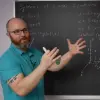

NARROW DISPLAY WARNING
You are most likely using a tablet or mobile device in portrait orientation. This website is best viewed using a typical computer screen with the browser window maximized.
Viewing this website in portrait orientation can cause problems with equations being longer than the screen width (you can scroll to the right), images being poorly sized, and the font size of maths text being much smaller than regular text. If your only option is a tablet or mobile device, your viewing experience will be better if you view this website in landscape orientation. You might need to refresh the page to fix any problems after rotating.
For those who would like to purchase their own 3D printed Rössler attractor, there are companies that will give a quote to 3D print an STL file you provide. I was able to find an STL file you can use on Thingiverse. There are a few models there, but one of them looks extremely similar to the physical model pictured below. (In fact, I wouldn't be surprised if that exact STL file was used since I found very few relevant search results.) That model fits in a 15cm cube.
The system of equations for the Rössler Attractor has three parameters and only one nonlinear term.
\begin{align} \frac{\text{d}x}{\text{d}t} &= -y-z \\ \frac{\text{d}y}{\text{d}t} &= x+ay \\ \frac{\text{d}z}{\text{d}t} &= b+z(x-c) \end{align}There are multiple values of the parameters that form a strange attractor, but the case when $a=0.2$, $b=0.2$, and $c=5.7$ has been studied by Rössler and many others.
The system undergoes period-doubling bifurcations when changing the parameters, leading to chaos. YouTube Video

This is a very small portion of all the interesting behaviours of the Rössler system. There are ways to apply iteration maps, bifurcations diagrams, fractals, and many other concepts from dynamical systems theory. There would generally be covered in an introductory dynamical systems course.